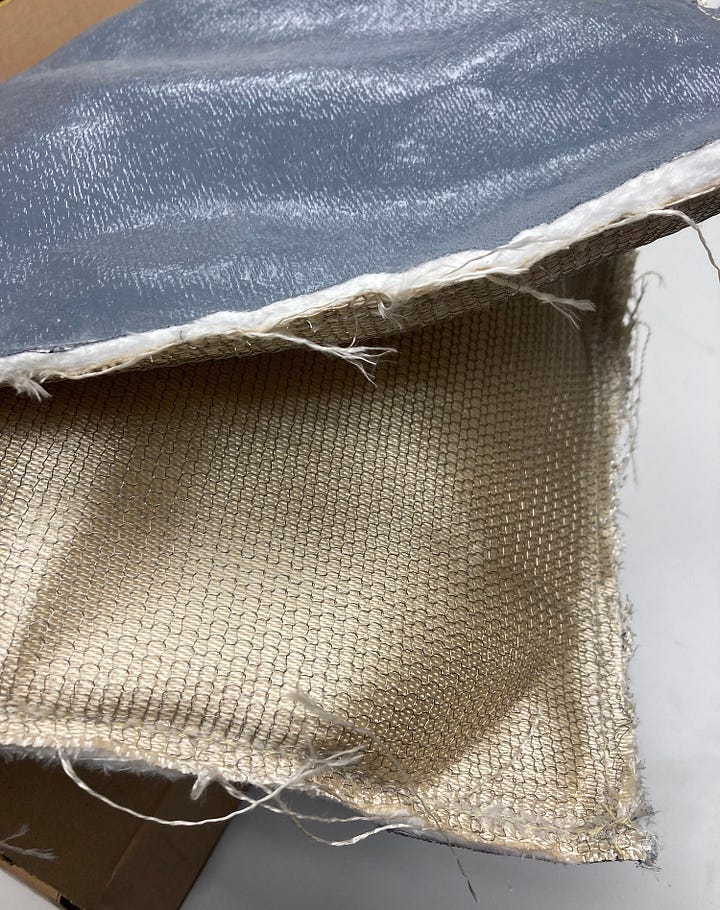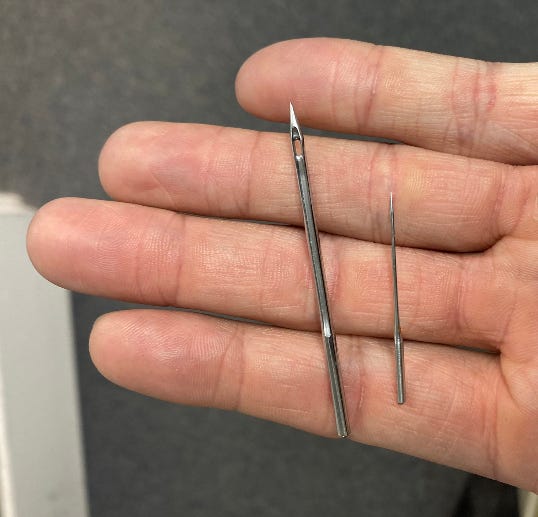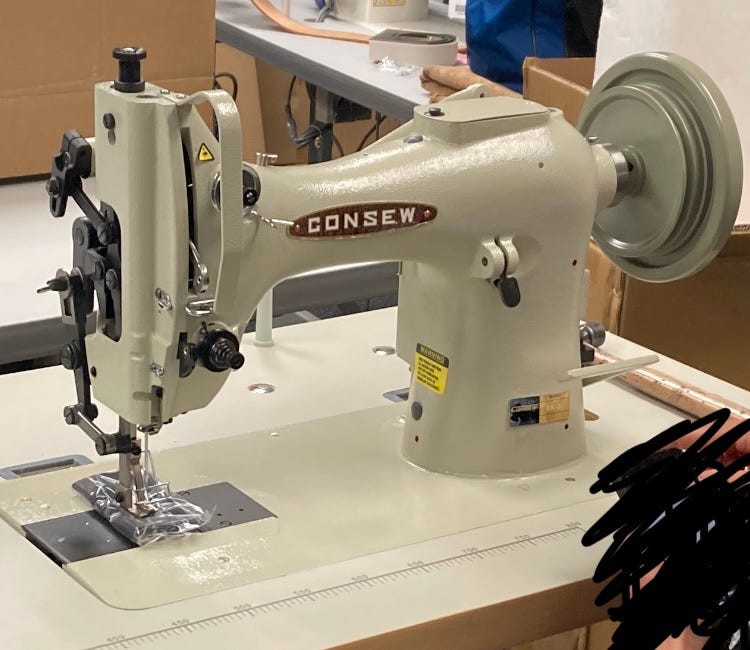Greetings everybody,
For this edition of The Sewing Machine Newsletter, I have unlocked an article that was previously only available to paid subscribers. This is not so much a sewing machine educational article but could be better classified as an essay or a think-piece.
I wish you all a Merry Christmas and a happy holiday season.
Thank you for reading.
-Cale
Maslow's Hierarchy of Needs Applied to Sewing
Have you ever heard of Maslow’s Hierarchy of Needs? It’s a theory of psychological motivation that offers an explanation for why a person does what they do. The essential idea is that needs lower down on the hierarchy must be satisfied before an individual can attend to his/her higher needs. From the bottom of the hierarchy upwards, the needs are physiological (food and clothing), safety (job security), love and belonging needs (friendship), esteem, and self-actualization.
In other words, Maslow’s hierarchy suggests that a person at their baseline is motivated to acquire food, water, shelter, and sleep. Once these physiological needs are met, the individual will be motivated by safety needs. Once their safety needs are met, they will be motivated to attain love and belonging. And so on up the hierarchy.
Whether or not it is 100% true, Maslow’s Hierarchy can be an interesting lens through which you can view the world. In this edition of The Sewing Machine Newsletter, I’ve played out a thought experiment where I applied Maslow’s Hierarchy to sewing— specifically, does Maslow’s Hierarchy of Needs provide a solid explanation of why people are motivated to sew?
Although I do not sew as a hobby, I work a full-time job as a sewing machine technician and a sewing machine salesman. Every day I speak to dozens of sewists of all different backgrounds and listen to all sorts of different sewing stories. Therefore, despite not sewing much myself, I believe I have developed a strong understanding of the reasons why people arrive in the sewing world and what motivates them to sew.
Physiological Needs - clothing, shelter, & sleep
I know an entire generation of sewists who began sewing due to physiological needs. They were initially motivated to sew for reasons that were utilitarian in nature. For example:
They first learned how to quilt because they needed blankets to keep them warm in the winter, and making one themselves was less expensive than going out and buying one.
They learned how to mend clothes because it was less expensive than going to a professional tailor.
They made their first dress themselves because that was the only way they were going to get a dress.
From my experience, the vast majority of people whose sewing origin story fits this narrative seem to be of the age where they either grew up during the Great Depression, or are the children of parents who struggled through the Great Depression. An interesting note is that I rarely meet young people with a similar sewing origin story. There is a stark generational divide in the reason why younger generations are motivated to sew.
Perhaps this is a subject for another day, but I do wonder if this type of sewing origin story is now extinct in 2023 America. The fact of the matter is that in 2023 it is less expensive to go buy clothes at some fast fashion retail store than it is to sew your own clothes due to the cost of machines, fabric, thread, notions, needles, etc. Thus, being motivated to sew to fulfill basic physiological needs appears to be on the decline. People who pick up sewing these days are motivated to do so for other reasons. I do not claim that it is a bad thing or a good thing, just that it reflects how times have changed.
Safety Needs - employment & health
It’s not difficult to make the argument that some people are motivated to sew in order to fulfill their “Safety Needs”, as I meet people every week who use their sewing machines as a means for employment. To them, a sewing machine represents job security. They are motivated to sew simply because they sew to make their living.
Here are a few common examples:
Auto, boat, and furniture upholstery.
Custom machine embroidery for clothing, hats, bags, etc.
Selling sewn goods such as masks and clothes on websites like Etsy and Poshmark
I think the average person would be surprised by the number of different industries that require sewing machines. Here are a couple of unusual examples I have seen over the past couple of years:
A business that makes dummy dogs out of fur and rubber. The dogs are made to mimic K-9 police dogs and alpine rescue dogs. The dummy dogs are used for police training and alpine rescue team training. The company uses Bernina-7 series machines, which our shop services about once a year — the amount of fur inside the machines is crazy.
A business that makes heavy-duty protective padding for specialty mining vehicles. These vehicles literally go thousands of feet below the earth’s surface to mine and are subject to extreme temperatures. Therefore, this hyper-protective padding must be strapped onto the outside of the vehicles for extra-protection. The padding is made out of a combination of rubber, canvas, and metal wire. In order to sew through all that, we had to special order a cartoonishly heavy-duty industrial machine from Consew.


If we want to broaden the umbrella of “Safety Needs”, I would also argue that some people are motivated to sew for their health:
I have heard many people say that they find sewing to be a very meditative activity, and some will go as far to say that it is their version of therapy.
Our shop donates old machines to a woman who runs a charity for military families and veterans. She works with a lot of veterans who suffer from PTSD and has told me that sewing helps alleviate their pain.
During the COVID-19 lockdowns in California, it seemed as if people were sewing more than ever. Many people claim that sewing helped them maintain their mental health and keep sane during that time.
Love & Belonging - friendship, family, sense of connection
Scientists have yet to prove the following claim with repeatable peer-reviewed experiments, but I can personally attest that sewing runs in the blood of certain people.
It’s not rare to meet someone who is motivated to sew because sewing is ingrained in their family culture like a strand of DNA. For these types of people, their motivation to sew comes from their family. They learned as a child on their mother's or grandmother’s machine. Sewing is simply what their family does. They make quilts together, they sew clothes together, sometimes out of utility and sometimes as a form of tradition. It’s all they’ve ever known. If you ask this type of person why they sew, they might respond with, “Why does a bird fly?” Because that’s what they were made to do.
In this same vein, I have even met quite a few people who will begin sewing later in life after inheriting their late mother’s machine. Perhaps they never took a liking to the activity as a child, but now that a family member has passed away, sewing on the machine they inherited gives them a sense of connection. Thus, their motivation to sew stems from the desire to attain familial connections.
Beyond the familial, many people are at least partially motivated to sew in order to form friendships with other like-minded folk. For proof, look no further than all the different sewing guilds across the United States. ASG (American Sewing Guild) has roughly 150 chapters across the country and each chapter meets on a regular basis. MQG (Modern Quilt Guild) has a similar structure. I’m sure there are other guilds I am not aware of, as well as smaller localized sewing groups. Another common thing I’ve been seeing more and more are sewing retreats, when a group of sewists organize a weekend trip and rent out a couple of cabins where they sew and drink wine.
Esteem - respect, self-esteem, recognition
Maslow divides this category into two parts: (1) “lower esteem” is a desire to attain respect from others; (2) “higher esteem is to attain self-respect.
Let’s use a quilter as an example.
A quilter who is motivated by “lower esteem” will make a quilt because they want respect from other sewists. They can attain this in a multitude of different ways. Perhaps they are motivated to quilt by the comments and likes they receive when they post photos of the finished product on social media. Perhaps they are motivated by the challenge of getting their quilt accepted into a festival or winning a competition.
A quilter who is motivated by “higher esteem” will make a quilt because they want to have self-respect. I can imagine someone like this challenging themself to make a quilt that is out of their comfort zone. By overcoming the obstacles one inevitably faces when challenging oneself with such tasks, they gain mental toughness and a sense of independence. Perhaps they set a goal to master a certain style or technique such as ruler work quilting. Once they can honestly tell themselves that they have grown to master ruler work, they gain the self-confidence that they can master anything they set their mind to. The prospect of gaining that self-respect is the proverbial "light at the end of the tunnel” that motivated them to start down the ruler work journey in the first place.
Self Actualization - desire to become the most that one can be
This one is the toughest for me to pin down. How do we define an abstract concept such as self-actualization? I turn to my guy Friedrich Nietzsche, who said:
If you feel the need to sew because the act of sewing is necessary for you to become who you are—to become the person you can be and must be— and you are at the point in your life where you feel the need to attain that ideal (the ideal of becoming who you are)— then that is the person who sews for self-actualization.
Who falls into this category?
The first type of person who comes to mind is the person who is a pure artist at heart. If someone is a true artist and sewing is their medium (fashion designer, tailor, quilter, etc.), and they are motivated to sew solely to fulfill their internal need to become the artist they are supposed to be, then they will sew for self-actualization. Maybe they enter their pieces in contests and submit them to festivals, but that is not why they sew. Acclaim from others is not what motivates them to sit down in front of their machine. The feeling of self-respect one gains from achieving some level of mastery— even that no longer serves as motivation. They do it because they feel the need to attain an ideal. That ideal is to become the most that they can be, and becoming the most they can be calls for sewing.
If we want to broaden the umbrella, I can also imagine a person who views the world in such a way that a human who reaches their full potential is a human who is completely self-sufficient. In this case, the act of sewing may be necessary for fulfilling this potential. They sew because the person they are destined to become lives completely off the grid; they grow their own food, they hunt for their meat, they sew their own clothes. Perhaps we could argue that this type of person is also motivated to sew in order to achieve self-actualization, for their version of self-actualization demands they become self-sufficient, and true self-sufficiency requires the occasional act of sewing.
Thank you for reading.
If you ever wondered what type of extra content paid subscribers have access to, I think this article is a fair representation.
Also, I personally have not studied much psychology, so any insights or thoughts from you all are more than welcome in the comments.
-Cale
Here are some of the other articles exclusive for paid subscribers:
Sewing Machines in Cinema
A list of my top 5 instances of sewing machines and sewists on the big screen. In my opinion, there is an obvious #1. Tell me if you disagree.
“Sewing Machine Almost Kill Me & Sewing Machine Save My Life”
The Amazing Story of Efim Tarakhovskaya, my friend and fellow Sewing Machine Man. Read Efim’s tale of being a sewing machine repairman in a large Moscow garment-making factory. His knowledge of sewing machines led him to love, romance, and near death in a Siberian Gulag. Eventually, that knowledge saved his life. Read all about it in his own words.
Shin Muryama Must Love Sewing Machines
Salute to a kindred spirit, Japanese artist and designer Shin Muryama. I first noticed Mr. Muryama when I stumbled across Twoness, a company that makes quality t-shirts with logos of sewing machines and fabric scissors. I became further enamored when I saw his series of bomber jackets that unexpectedly combine a myriad of different sewing techniques. Then I discovered his masks and became completely enamored in the extremely unique Japanese sewist.









Great article! Sewing is definitely in my family. My father's mother was a professional self employed seamstress which helped support her family. A good number of female ancestors sewed for a living and some taught others. On my mom's side, everyone sewed, but mostly to make their own clothes. An example is my mother's mother who was very diminuitive and slim. She often altered clothes to fit her small frame. She made my mother's wedding dress. My mother weighed 95 lbs, and kept losing weight due to nervousness. So there were constant adjustments.
Mom made all our clothes except for jeans. She made my Dad's tuxedo. Both my sister and I learned to sew early. I also needed to make clothes to fit as store bought often didn't fit. Mom also was creative, and I had some interesting outfits in my teens. Later she was part of a quilting group. She also embroidered and crocheted as did I.
So we had need, safety, love and belonging, and self esteem. I think our interests were varied, so we did a lot of other things besides sewing. Maybe that was self-actualization. :)
I just came across this article, and I can relate, in so many ways! I have 4 sisters, and my mother made ALL our clothes: dresses, suits, even coats for cold NY winters! Strangely, the oldest and the youngest of us missed the sewing gene, along with the knitting and crocheting gene. I'm still at all of the above, and have been on sewing retreats. You're right about the wine!